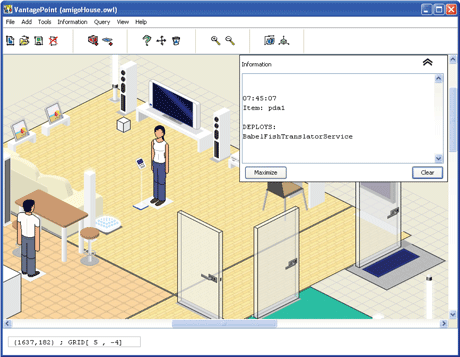by Jarmo Kalaoja, Julia Kantorovitch, Toni Piirainen and Ilkka Niskanen
Service-oriented architectures, Web services, Semantic Web, ontologies, OWL, RFD, OWL-S any chance for the service developer and original user (eg researcher) to survive in understanding of the complex world of today's service-related semantic technology? Researchers in the VTT Software Architectures and Platforms department are developing a VantagePoint tool, which will help designers and developers to better understand semantic service-oriented architectures (SOAs). An understanding of semantics will enable application designers to choose appropriate ontologies for their applications, and to determine which semantic-based approaches are beneficial and what can be easily integrated with semantic reference architectures.
Pervasive computing is the trend towards increasingly ubiquitous, connected computing devices in the environment, and is being brought about by a convergence of advanced electronic, wireless technology with the Internet. Pervasive computing devices can be mobile or embedded in almost any type of physical environment (eg home, office or car) imaginable, and all communicate through increasingly interconnected networks.
It is expected that in the future, smart devices all around us will maintain current information about their locations and the contexts in which they are being used, as well as relevant data about the users. Computing will become so naturalized within the environment that people will not even realize that they are using computers.
To this end, researchers are looking for innovative concepts and approaches. Among the emerging technology expected to prevail in the pervasive computing environment of the future are service-oriented architectures (SOAs) and semantic ontology-based technologies. SOAs provide a means of resolving the complexity, heterogeneity and dynamicity issues, abstracting the complexity of involved systems and enabling loose and dynamic coupling among heterogeneous resources through automated service publication and run-time service discovery and composition. Semantic ontology-based technologies (eg RDF, RDF-S, OWL, OWL-S, ontologies and reasoning tools) promise far more effective machine-to-machine communication. The use of ontologies enables computational entities and services to use a common set of concepts and vocabularies to represent knowledge about a domain of interest, and to interact with each other. This allows the relationships between entities to be more clearly expressed and thus better reasoning on their properties.
In the IST Amigo project, which aims to develop an open networked home system as part of the ambient intelligence pervasive computing vision, we adapt semantic modelling approaches to effectively integrate, discover and compose heterogeneous services and devices in a ubiquitous and seamless manner in order to address user requirements. Web Services and OWL-S are adopted as a convenient paradigm for service representation in Amigo. The purpose of ontologies is to enrich service descriptions, including both the functional (service capabilities, inputs, outputs) and non-functional properties of services. The non-functional properties of a service, such as quality of service (QoS), the context in which it is executed and the preferences specified in user profiles, may assist in dynamically selecting the services that best meet user needs.
However, before such reference service discovery architecture can be implemented, effectively used and widely accepted, the ontology-based semantics for networked devices and services must be well understood. An understanding of semantics will enable application designers to choose which ontologies can be used in their applications. An understanding of how semantics can be used will help application and service developers to determine which semantic-based approaches will be beneficial to the support of their applications, and what is required to be easily integrated in such reference architecture.

To offer a comprehensive response to the above concerns, researchers in the VTT Software Architectures and Platforms department are developing a VantagePoint tool, which will make the contextual semantic information related to service descriptions easier to understand, and its use by an application developer foolproof. The tool allows users to view ontology instances associated with complex contextual information in a more illustrative and comprehensible way. It also allows users to semantically model and interactively simulate contextual environments of interest. These may be either physical real-world (ie devices, services, functional capabilities of service, contexts) or conceptual (business boundaries, networking or security domains). It supports the conceptual design of applications (eg verifying a service composition logic) or middleware-level services (eg semantic service discovery) against one or more contextual scenarios. Moreover, we believe that the research presented is a step toward the better understanding and wider acceptance of ontology-based semantic technology also for non-Web services.
VantagePoint is written in Java; it uses the Jena interface to manage OWL ontologies, and Java 2D graphics to visualize them. VantagePoint can have several visualization libraries containing domain-specific icons. These libraries are stored as simple text files that contain URLs of the icon files providing isometric visualization from different perspectives (PNG images), and a URL of a semantic class description in one of VantagePoint's semantic libraries. A browser tool is provided for examining the visualization libraries. While the current libraries relate to intelligent home applications, future elements will describe other intelligent environments such as car, plane, or mobile outdoor domain.
Links:
http://www.hitech-projects.com/euprojects/amigo/
http://www.vtt.fi/proj/vantagepoint/
Please contact:
Julia Kantorovitch, Jarmo Kalaoja
VTT, Finland
Tel: +358 20 722 2334
E-mail: Julia.Kantorovitch![]() vtt.fi, Jarmo.Kalaoja
vtt.fi, Jarmo.Kalaoja![]() vtt.fi
vtt.fi










